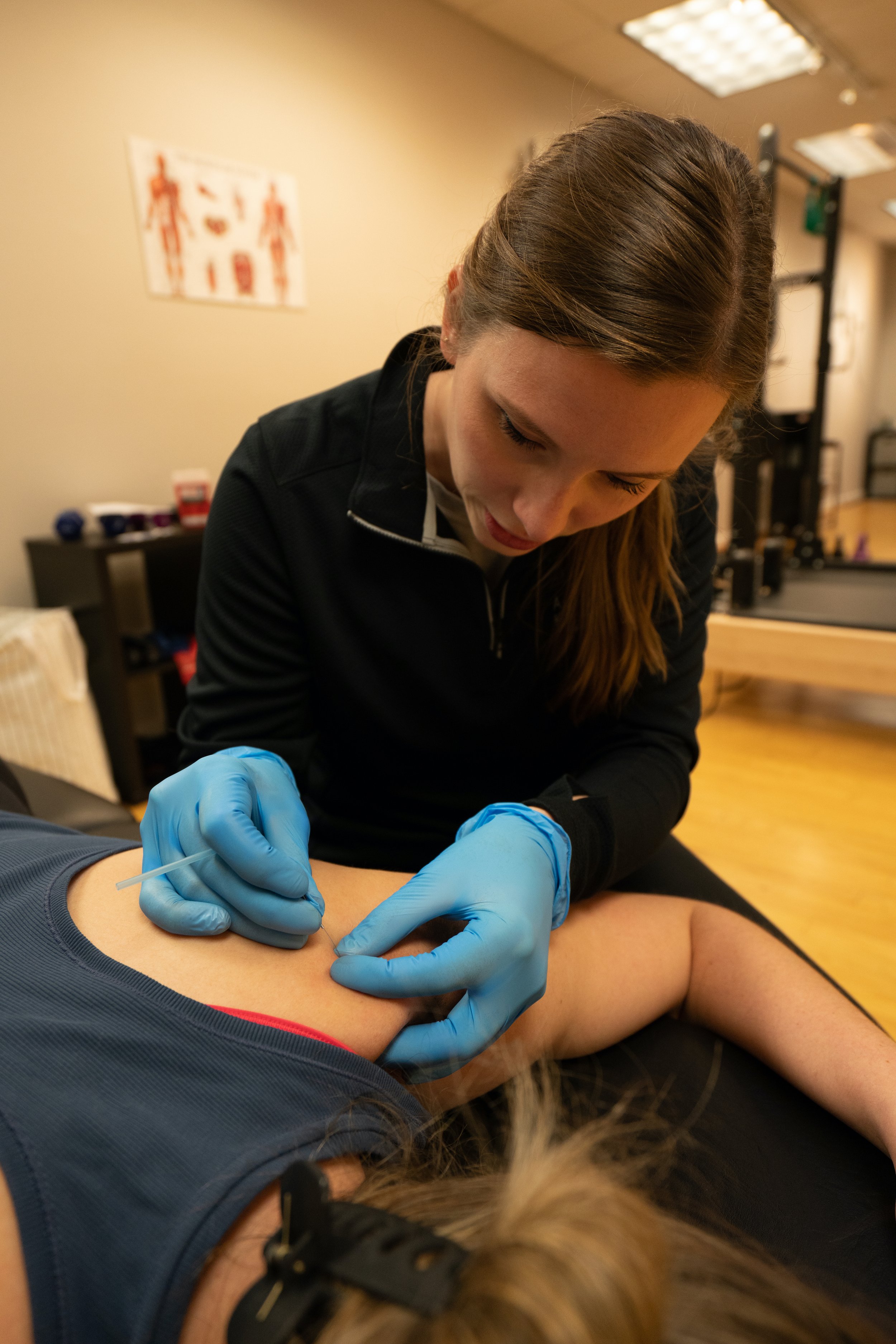Absolute Kinetics Physical Therapy Blog
What is Vaginismus?
Vaginismus is a condition in which your body automatically contracts the pelvic floor muscles when penetration/insertion occurs. The pelvic floor muscles play an important role in sexual function and the ability to have pain free penetration/insertion. While this is deemed a sexual function “issue”, it is not limited to sex/intimacy, but can also include painful/limited insertion of things like tampons and painful pelvic exams in general.
Am I Fueling My Lifestyle Appropriately? Nutrition View from a Doctor of Physical Therapy
You may be wondering, “what is a Physical Therapist interested in nutrition for?” As a direct access, cash basis Physical Therapist I care and look at the whole person! How we eat is how we fuel all the activities and movements that we want to do! Different activities require very different nutritional intake to optimize performance and reduce injury risk. That means marathon runners should have different intake pattern compared to power lifters. Both may have very different nutrition requirements compared to a 30+ working dad who only gets to the gym 3-4 times per week (if I am being optimistic!).
Skill Update: Dry Needling and How It Fits Within the Practice
Resolving trigger points is a crucial part of attaining good biomechanics. Trigger points or “knots” in muscles can cause tissue damage and dysfunction. This damage and dysfunction can limit biomechanics and cause issues in muscle and nerve performance.
How Does the Pelvic Floor Affect Bowel Health?
Yes, Your pelvic floor can be messing with your bowel movements! While it’s something people often don’t like to talk about, pooping is an important and healthy part of life. Whether having a bowel movement is painful and/or infrequent, we’re usually only met with advice to eat more fiber, drink more water, and eat more vegetables. While these tips are important for a healthy system in general, it is not the whole picture.
Are Your Joints Ready for Spring?
Spring is almost here and along with it all the great outdoor activities that come with increased sunshine and warmth! Whether you hike, garden, or are looking to throw a baseball, here is a warmup routine with a twist to prepare your body to move!
What is Dry Needling?
Dry Needling is a technique used by physical therapists and other practitioners in order to target and influence the myofascial system. The myofascial system is a complex network made up of muscles and fascia, as well as nerves, blood vessels, and the lymphatic system. When there is tension and restriction in these structures, it often leads to a decreased level of blood flow and function. This in turn heightens our nervous system’s response by increasing our perception of pain in the area. This causes us to be in this cycle of pain, tension, decreased blood flow, and more pain. Techniques such as trigger point dry needling are a great way to directly release the tension and break the cycle.
Do you get pain during or after running?
Running has a lot of moving pieces (no pun intended) that are slightly different for each of us. Some of us are natural forefoot runners, others are natural heel strikers. Some of us use a lot of arm swing to facilitate acceleration and others have a rigid arm pattern, propelling entirely from the lower extremities. Our bodies have wonderful individuality and variation which means our running patterns are individual as well. With different running styles come different muscle and energy requirements and different risks for varying aches, pains, and injuries.
The Connection Between Pelvic Floor Dysfunction and Hip Pain
When people think of pelvic floor issues, it often involves symptoms such as urinary incontinence or pain with intercourse/sexual function issues. There are many more connections we can make in the body to the pelvic floor, including the hip. The hip joint is connected to the pelvis and works to provide stability and movement to the body.
Exercise and Lifting During Pregnancy
For far too long, pregnant people have been treated differently. They’re met with numerous limitations and advice on the things that they “can’t” do. While some pregnancies do need these limitations, most healthy pregnant people only need to make specific modifications throughout pregnancy and can actually continue doing the things they like to do, especially lifting.
Why Should I See a Physical Therapist First for Low Back Pain?
Low back pain is very common, and is the leading cause of activity limitation and work absence throughout much of the world. Individuals who have experienced activity-limiting low back pain often experience reoccurring episodes, and the prevalence of chronic low back pain has also significantly increased. Current research does not support a definitive cause for initial episodes of low back pain, and risk factors associated with low back pain are multifactorial, population specific, and only weakly associated with the development of low back pain (therefore, it is hard to "prevent" low back pain, as there are many factors that play a role!).
The Link Between Neck Pain and Headaches
There are several different kinds of headaches, including migraines, tension headaches, and cervicogenic headaches. Each different type of headache has different causes and treatments. It is important if you suffer from chronic and frequent headaches to be evaluated by a qualified medical professional to determine which type of headache you are experiencing, and what course of treatment may provide the best chance at relief.
Do I Need an X-Ray or MRI Before Physical Therapy?
A common question we hear as Physical Therapists - how are you going to treat me without seeing my MRI? (Or variations of this - why do I need to see you before I have an MRI? Don’t you need a diagnosis to treat me? Etc). To answer this question, we need to start with what we actually look at during our Physical Therapy assessment, and how that guides our treatment.
What is Visceral Manipulation?
Visceral Manipulation has been found to be beneficial for many disorders, including digestive disorders, acute and chronic pain and injury, women's and men's pelvic health issues, musculoskeletal disorders, emotional issues, and more. This treatment approach evaluates and treats the dynamics of motion in relation to organs, membranes, fascia, and ligaments. The goal of Visceral Manipulation is to improve awareness and communication in the body through gentle manual techniques to the organs.
The Answer to Constipation is Not Always Fiber and Laxatives
Nearly 30% of the US population experiences constipation. While some causes involve diet, hydration, stress, and even which medications you may be taking, an often-overlooked source is the function of the pelvic structures themselves.
What is Sciatica and What Can I Do About It?
Sciatica is a common diagnosis and occurs when the sciatic nerve, which runs down the back of the leg and supplies many of the muscles in the back and side of the leg, is being pinched or irritated by some other structure. Although the diagnosis of sciatica is very common, it is also very frequently misunderstood and misdiagnosed.
Pregnancy and Birth Prep - Yes there are options!
While pregnancy can be an exciting time, it causes a lot of changes in the body that can leave the pregnant person in a lot of discomfort and pain. Because these changes are natural, I often hear people say things like “I just have to get through a few more months” or “There is no point addressing something that is temporary”. While I understand that pregnancy is temporary and that there are a million other things on a pregnant person’s plate, I want everyone to know that you do not have to live with all of these pains and that you can actually do a lot to promote a safe and healthy pregnancy that prepares you for birth.
How Does Physical Therapy Help with Pelvic Pain?
Pelvic Pain is often described as a discomfort or painful/abnormal sensation anywhere around the pelvis, including but not limited to the abdomen, pelvis, and perineum. This covers a vast amount of different diagnoses, but there is one thing the majority of them have in common; pelvic health physical therapy can drastically help improve symptoms and quality of life.
Do You Take My Insurance?
Absolute Kinetics has chosen a cash-based model for our practice. We feel this model is the most efficient and effective way to provide physical therapy services. Here are a few benefits of the cash-based model.
What Type of Exercise Should I Do If I Am Hypermobile?
We see a lot of patients in our clinic who have some level of hypermobility, and most of them don't feel clear about what they should and should not be doing in the gym. If you have read any of our blog posts in the past, I am sure you know the first thing I am going to say: it depends.
“But I Only Pee When I Jump…”
This is one of the most common things I hear. Imagine you come in for a physical therapy appointment with a primary complaint of hip or low back pain. As a pelvic health PT, I ask you a lot of questions you probably aren’t used to but that are related to how the pelvic floor muscles are functioning (how many times do you pee in a day? Is your urine stream straight or does it veer to the side? What does your poop look like? Do you have pain with sex? Are you able to orgasm?). You say that you don’t really have urinary leakage, but whenever you do jumping jacks or double unders, you do pee a tiny bit. That’s normal, right? Nope!




















